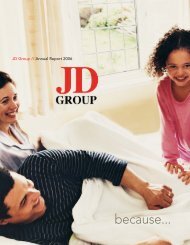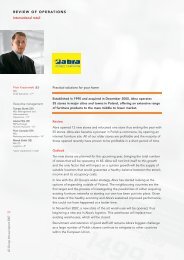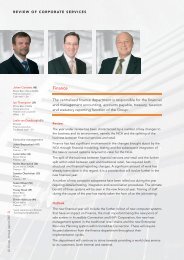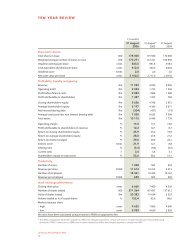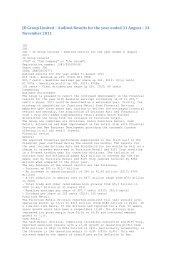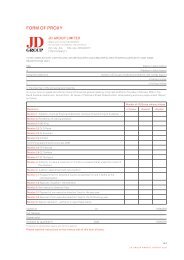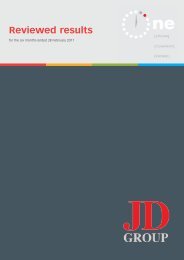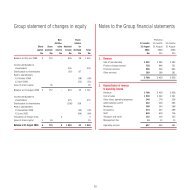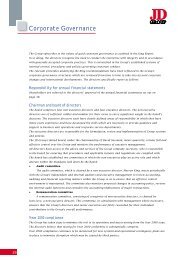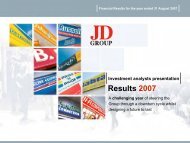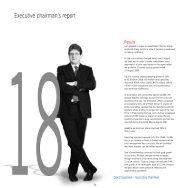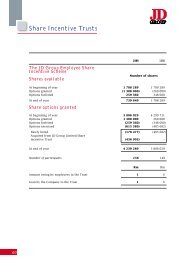Annual Report - JD Group
Annual Report - JD Group
Annual Report - JD Group
You also want an ePaper? Increase the reach of your titles
YUMPU automatically turns print PDFs into web optimized ePapers that Google loves.
Corporate governance continued<br />
Financial control and reporting<br />
The directors are responsible for ensuring that <strong>Group</strong> companies<br />
maintain adequate records, and for reporting on the financial<br />
position of the <strong>Group</strong> and the results of the activities with<br />
accuracy and reliability. Financial reporting procedures are applied<br />
in the <strong>Group</strong> at all levels to meet this responsibility. Financial and<br />
other information is constantly reviewed and remedial action<br />
taken, where necessary.<br />
Improvements to the quality of reported information are continually<br />
effected by means of replacing or upgrading information systems.<br />
The <strong>Group</strong>’s financial statements are prepared in accordance with<br />
South African Statements of Generally Accepted Accounting<br />
Practice and International Financial <strong>Report</strong>ing Standards as well as<br />
the consistent use of appropriate accounting policies, unless an<br />
accounting policy requires revision or adoption of new accounting<br />
standards, in which case proper disclosure will be made,<br />
supported by reasonable and prudent judgements and estimates,<br />
in order to properly disclose the <strong>Group</strong>’s financial status.<br />
Internal control and internal audit<br />
The board has overall responsibility for ensuring that the <strong>Group</strong><br />
maintains a system of internal financial control to provide it with<br />
reasonable, but not absolute, assurance regarding the reliability of<br />
the financial information used within the business and for<br />
publication, and to ensure that assets are safeguarded.<br />
The key features of the internal control systems that operated<br />
throughout the year under review are described hereunder.<br />
Control environment<br />
A documented organisational structure with clearly defined lines<br />
of responsibility and delegation of authority from the board to the<br />
chains and corporate service departments is in place. The board<br />
has established policies and procedures, including a levels of<br />
authority document and a code of conduct, to foster a strong<br />
ethical climate.<br />
Financial monitoring systems<br />
The <strong>Group</strong> operates a comprehensive annual planning and<br />
budgeting process. The annual budget is approved by the board.<br />
The financial reporting system compares results with plans,<br />
budgets and the previous year and is able to identify deviations on<br />
a daily and monthly basis. <strong>Report</strong>s include regular cash flow<br />
statements, income statements and balance sheets projected for<br />
12 months, which are used in determining future funding needs.<br />
Main control procedures<br />
The directors have adopted a schedule of matters which are<br />
required to be brought to it for decision, thus ensuring that it<br />
maintains full and effective control over appropriate strategic,<br />
financial, organisational and compliance issues. The board has<br />
identified a number of key areas which include treasury, legislative<br />
requirements, information technology, strategic business goals<br />
and other matters which are subject to regular reporting. Financial<br />
controls and procedures are in place, including procedures for<br />
seeking and obtaining approval for major transactions and<br />
8<br />
organisational changes. Organisational controls involving the<br />
segregation of incompatible duties and controls relating to the<br />
security of assets are also covered.<br />
The board regularly reviews the operations and effectiveness of<br />
internal financial control. The board considers that there have<br />
been no weaknesses which have led to any material losses or<br />
contingencies during this financial year.<br />
Internal control<br />
The directors accept responsibility for maintaining appropriate<br />
internal control systems to ensure that the <strong>Group</strong>’s assets are<br />
safeguarded and managed, and losses arising from fraud or other<br />
illegal acts are minimised. Control systems are monitored and<br />
improved in accordance with generally accepted best practice.<br />
Internal audit<br />
Internal audit is an independent, objective assurance and<br />
consulting function designed to add value to and improve the<br />
<strong>Group</strong>’s operations. It helps the <strong>Group</strong> accomplish its objectives<br />
by bringing a systematic, disciplined approach to evaluate and<br />
improve the effectiveness of risk management, control and<br />
compliance processes. It provides:<br />
assurance that the management processes are adequate to<br />
identify and monitor significant risks;<br />
confirmation of the adequacy and effective operation of the<br />
established internal control systems;<br />
credible processes for feedback on risk management and<br />
assurance; and<br />
objective confirmation that the board receives assurance from<br />
management that information is reliable.<br />
The purpose, authority and responsibility of the internal audit<br />
activity are formally defined in an internal audit charter, which is<br />
approved by the board, and which is consistent with the Institute<br />
of Internal Auditors’ definition of internal auditing.<br />
The activities of the internal auditors are co-ordinated by the<br />
<strong>Group</strong> internal audit executive, with unrestricted access to the<br />
audit committee chairman and its members.<br />
Internal audit co-ordinates with the external auditors to ensure<br />
proper coverage and to minimise duplication of effort. The<br />
external auditors also review reports issued by internal audit.<br />
Audit plans for each chain are tabled annually to take account of<br />
changing business needs. Follow up audits are conducted in areas<br />
where weaknesses are identified.<br />
The internal audit plan, approved by the audit committee, is based<br />
on risk assessments, which are of a continuous nature so as to<br />
identify not only existing and residual risks, but also emerging<br />
risks, as well as issues highlighted by the audit committee and risk<br />
management committee. Internal audits are conducted formally<br />
at each chain workplace and corporate service department on<br />
aregular basis.




